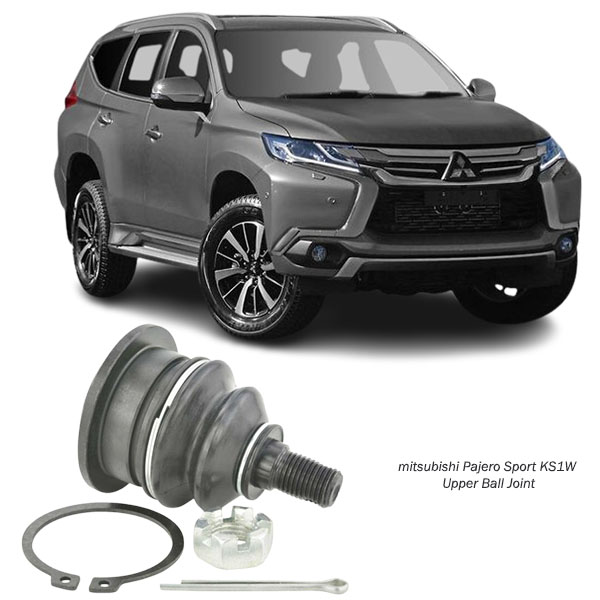-9%
Get Mitsubishi Pajero Sport KS1W Upper Ball Joint 0420-KK4TUPF in Kenya
Ball joints are crucial components of a vehicle’s suspension system, connecting the control arms to the steering knuckles or spindles. They allow for smooth movement and articulation of the suspension while supporting the weight of the vehicle and enabling steering. Understanding the functions of ball joints and recognizing signs of wear is essential for maintaining vehicle safety and performance.
Functions of Ball Joints:
-
Connecting Control Arms and Steering Knuckles
- Function: Ball joints serve as the connecting points between the control arms (upper and lower) and the steering knuckles.
- Importance: This connection allows for the transfer of movement and forces from the steering and suspension systems to the wheels, enabling proper vehicle control.
2. Allowing Multi-Directional Movement
- Function: Ball joints facilitate multi-directional movement, allowing the wheels to move up and down, and also pivot left and right.
- Importance: This movement is crucial for maintaining proper wheel alignment and ensuring smooth handling and ride comfort over various road conditions.
3. Enabling Steering
- Function: Ball joints enable the wheels to pivot when the driver turns the steering wheel.
- Importance: This is essential for steering control, allowing the vehicle to navigate turns and maneuvers accurately and safely.
4. Absorbing Road Shocks and Vibrations
- Function: Ball joints help absorb shocks and vibrations from the road, reducing the transfer of these forces to the vehicle’s chassis.
- Importance: This absorption improves ride quality and comfort, protecting other suspension components from excessive wear and damage.
5. Maintaining Wheel Alignment
- Function: Ball joints play a role in maintaining proper wheel alignment by keeping the suspension components in their correct positions.
- Importance: Proper alignment is crucial for even tire wear, optimal handling, and overall vehicle stability.
6. Supporting Vehicle Weight
- Function: Ball joints, especially the lower ball joints, bear a significant portion of the vehicle’s weight.
- Importance: They provide the necessary support to maintain the vehicle’s height and ensure that the suspension system functions correctly.
7. Facilitating Suspension Movement
- Function: Ball joints allow the suspension system to move independently of the vehicle’s body.
- Importance: This independent movement is essential for absorbing bumps and maintaining tire contact with the road, which enhances traction and safety.
Signs of Worn Out Ball Joints:
-
Clunking or Knocking Noises
- Explanation: Worn ball joints can cause metal-to-metal contact as the protective rubber boots degrade, leading to noise.
- Symptoms: Clunking, knocking, or rattling sounds coming from the front suspension, particularly noticeable when driving over bumps, potholes, or rough terrain. These noises are often more pronounced when making turns or during sudden changes in direction.
2. Excessive Vibration
- Explanation: As ball joints wear out, they can become loose and cause vibrations.
- Symptoms: Noticeable vibrations in the steering wheel, especially when driving at higher speeds. The vibrations may increase with speed and become more pronounced on uneven surfaces.
3. Uneven Tire Wear
- Explanation: Worn ball joints can lead to improper alignment, causing tires to wear unevenly.
- Symptoms: Inspect your tires for signs of uneven wear, such as more wear on the inner or outer edges of the tires. This uneven wear pattern indicates alignment issues often caused by faulty ball joints.
4. Steering Problems
- Explanation: Ball joints are crucial for maintaining precise steering control.
- Symptoms: Steering may feel loose, or you might experience increased play in the steering wheel. The vehicle may also drift to one side or the other, making it difficult to maintain a straight line.
5. Poor Handling and Stability
- Explanation: Ball joints help maintain proper wheel alignment and suspension geometry.
- Symptoms: The car may feel unstable or loose, especially when cornering or driving on uneven surfaces. You might notice excessive body roll or sway during turns.
6. Unusual Tire Movement
- Explanation: Worn ball joints can cause excessive movement in the suspension.
- Inspection: When the vehicle is lifted, check for any unusual movement or play in the wheels. Grab the tire at the top and bottom and try to rock it back and forth. Excessive movement can indicate worn ball joints.
7. Squeaking or Creaking Sounds
- Explanation: As the lubrication in the ball joints diminishes, the joints can start to squeak.
- Symptoms: Squeaking or creaking sounds when turning the steering wheel or going over bumps, especially at low speeds.
8. Visual Inspection
- Explanation: Physical signs of wear and damage can often be seen upon close inspection.
- Inspection: Look for cracked or torn rubber boots around the ball joints, which can lead to dirt and moisture entering the joint and causing accelerated wear. Also, check for rust, corrosion, or any signs of grease leakage.
9. Suspension Sag
- Explanation: Worn ball joints can cause the suspension to sag, affecting vehicle height and alignment.
- Symptoms: One side of the vehicle may appear lower than the other, indicating uneven suspension height due to worn ball joints.
10. Difficulty Aligning Wheels
- Explanation: Worn ball joints can prevent proper wheel alignment.
- Symptoms: If you’ve recently had an alignment done and the vehicle still pulls to one side or the alignment does not hold, it may indicate ball joint issues.
Follow us on Facebook for more parts.



